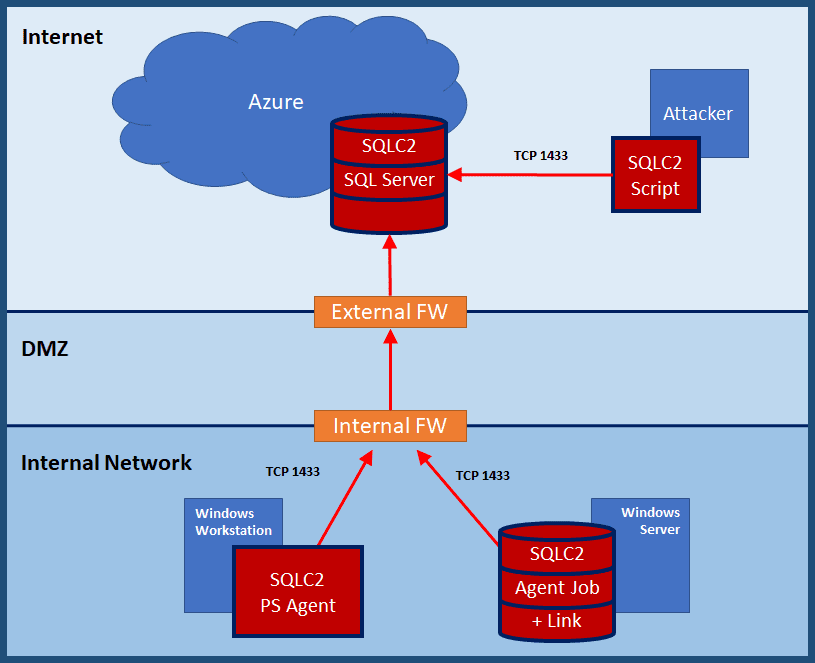
SQLC2
SQLC2 is a PowerShell script for deploying and managing a command and control system that uses SQL Server as both the control server and the agent. At its core, SQLC2 is just a PowerShell script, a TSQL script, and a few tables in an SQL Server instance that tracks agents, commands, and results. Nothing too fancy, but it may prove to be useful on some engagements.
For a more complete overview of SQLC2 check out the blog here.
More companies are starting to use Azure SQL Server databases. When those Azure SQL Server instances are created, they are made accessible via a subdomain of database.windows.net on port 1433. For example, I could create SQL Server instance named “mysupersqlserver.database.windows.net”. As a result, some corporate network configurations allow outbound internet access to any “database.windows.net” subdomain on port 1433.
The general idea is that as Azure SQL Server adoption grows, there will be more opportunity to use SQL Server as a control channel that looks kind of like normal traffic. SQLPS is a pretty basic proof of concept, but I think it’s functional enough to illustrate the idea. I know there are quite a few improvements to be made, but if you end up playing with it, I’d love your feedback.
Although there is an emphasis on using SQLC2 with Azure SQL Server instances, you could host your own SQL Server in any cloud environment and have it listen on port 443 with SSL enabled. So, it could offer a little more flexibility depending on how much effort you want to put into it.

Download
git clone https://github.com/NetSPI/SQLC2.git
Use
- Option 1: Download the script and import it. This does not require administrative privileges and will only be imported into the current session. However, it may be blocked by restrictive execution policies, so you may want to use the bypass option.Set-ExecutionPolicy Bypass -Scope Process
Import-Module SQLC2.ps1
- Option 2: Load it into a session via a downloading cradle. This does not require administrative privileges and will only be imported into the current session. It should not be blocked by executions policies.IEX(New-Object System.Net.WebClient).DownloadString(“https://raw.githubusercontent.com/NetSPI/SQLC2/master/SQLC2.ps1”)
Note: To run as an alternative domain user, use the runas command to launch PowerShell first.
runas /noprofile /netonly /user:domain\user PowerShell.exe
Below is a list of user functions that support the intended workflows.
| Function Name | Description |
|---|---|
| Install-SQLC2Server | Install SQLC2 tables on target SQL Server/database. |
| Install-SQLC2AgentPs | Install an agent that uses an SQL Server agent job and server link. |
| Install-SQLC2AgentLink | Install an agent that uses a scheduled task or registry key to execute PowerShell commands. |
| Set-SQLC2Command | Set operating system commands for agents to run. |
| Get-SQLC2Command | Get a list of pending operating system commands from the C2 for the agent. This can also execute the pending command with the -Execute flag. |
| Get-SQLC2Agent | Get a list of agents registered on the SQLC2 server. |
| Get-SQLC2Result | Get a list of pending and completed commands. Support servername, status, and cid filters. |
| Remove-SQLC2Agent | Remove agents registered on the SQLC2. Simply clears the history. |
| Remove-SQLC2Command | Remove the command history on the SQLC2 server. |
| Uninstall-SQLC2AgentLink | Uninstall SQLC2 agent that uses server links and an agent job. |
| Uninstall-SQLC2AgentPs | Uninstall all operating system based persistence methods. |
| Uninstall-SQLC2Server | Remove the SQLC2 tables from the target database. |
Copyright (c) 2018, NetSPI
All rights reserved.
Source: https://github.com/NetSPI/